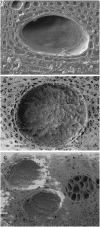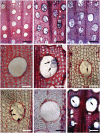Ethylene and not embolism is required for wound-induced tylose development in stems of grapevines
- PMID: 17921344
- PMCID: PMC2151685
- DOI: 10.1104/pp.107.100537
Ethylene and not embolism is required for wound-induced tylose development in stems of grapevines
Abstract
The pruning of actively growing grapevines (Vitis vinifera) resulted in xylem vessel embolisms and a stimulation of tylose formation in the vessels below the pruning wound. Pruning was also followed by a 10-fold increase in the concentration of ethylene at the cut surface. When the pruning cut was made under water and maintained in water, embolisms were prevented, but there was no reduction in the formation of tyloses or the accumulation of ethylene. Treatment of the stems with inhibitors of ethylene biosynthesis (aminoethoxyvinylglycine) and/or action (silver thiosulfate) delayed and greatly reduced the formation of tyloses in xylem tissue and the size and number of those that formed in individual vessels. Our data are consistent with the hypotheses that wound ethylene production is the cause of tylose formation and that embolisms in vessels are not directly required for wound-induced tylosis in pruned grapevines. The possible role of ethylene in the formation of tyloses in response to other stresses and during development, maturation, and senescence is discussed.
Figures






Similar articles
-
Pruning-induced tylose development in stems of current-year shoots of Vitis vinifera (Vitaceae).Am J Bot. 2006 Nov;93(11):1567-76. doi: 10.3732/ajb.93.11.1567. Am J Bot. 2006. PMID: 21642102
-
Xylella fastidiosa infection and ethylene exposure result in xylem and water movement disruption in grapevine shoots.Plant Physiol. 2007 Feb;143(2):1024-36. doi: 10.1104/pp.106.087023. Epub 2006 Dec 22. Plant Physiol. 2007. PMID: 17189331 Free PMC article.
-
Wound-induced vascular occlusions in Vitis vinifera (Vitaceae): Tyloses in summer and gels in winter1.Am J Bot. 2008 Dec;95(12):1498-505. doi: 10.3732/ajb.0800061. Epub 2008 Oct 31. Am J Bot. 2008. PMID: 21628157
-
Vascular occlusions in grapevines with Pierce's disease make disease symptom development worse.Plant Physiol. 2013 Mar;161(3):1529-41. doi: 10.1104/pp.112.208157. Epub 2013 Jan 4. Plant Physiol. 2013. PMID: 23292789 Free PMC article.
-
In vivo visualization of the final stages of xylem vessel refilling in grapevine (Vitis vinifera) stems.New Phytol. 2018 Jan;217(1):117-126. doi: 10.1111/nph.14811. Epub 2017 Sep 20. New Phytol. 2018. PMID: 28940305
Cited by
-
Complete tylosis formation in a latest Permian conifer stem.Ann Bot. 2013 Jun;111(6):1075-81. doi: 10.1093/aob/mct060. Epub 2013 Mar 26. Ann Bot. 2013. PMID: 23532049 Free PMC article.
-
Bark wounding triggers gradual embolism spreading in two diffuse-porous tree species.Tree Physiol. 2024 Feb 6;44(1):tpad132. doi: 10.1093/treephys/tpad132. Tree Physiol. 2024. PMID: 37930242 Free PMC article.
-
Xylella fastidiosa: an examination of a re-emerging plant pathogen.Mol Plant Pathol. 2018 Apr;19(4):786-800. doi: 10.1111/mpp.12585. Epub 2017 Oct 24. Mol Plant Pathol. 2018. PMID: 28742234 Free PMC article.
-
Genome-Wide Identification and Characterisation of Stress-Associated Protein Gene Family to Biotic and Abiotic Stresses of Grapevine.Pathogens. 2022 Nov 27;11(12):1426. doi: 10.3390/pathogens11121426. Pathogens. 2022. PMID: 36558760 Free PMC article.
-
Exploring the Hydraulic Failure Hypothesis of Esca Leaf Symptom Formation.Plant Physiol. 2019 Nov;181(3):1163-1174. doi: 10.1104/pp.19.00591. Epub 2019 Aug 27. Plant Physiol. 2019. PMID: 31455632 Free PMC article.
References
-
- Abeles FB, Morgan PW, Saltveit ME Jr (1992) Ethylene in Plant Biology, Ed 2. Academic Press, San Diego
-
- Amrhein N, Wenker D (1979) Novel inhibitors of ethylene production in higher plants. Plant Cell Physiol 20 1635–1642
-
- Arshad M, Frankenberger WT Jr (1991) Effects of soil properties and trace elements on ethylene production in soils. Soil Sci 151 377–386
-
- Beckman CH (1966) Cell irritability and localization of vascular infections in plants. Phytopathology 56 821–824
Publication types
MeSH terms
Substances
LinkOut - more resources
Full Text Sources

